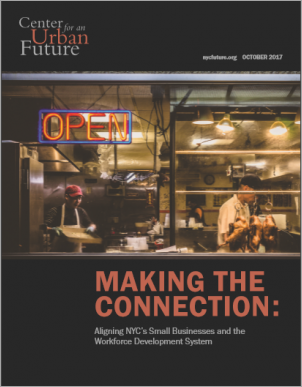Improve employer-focused workforce development for all businesses. Most workforce development programs treat the jobseeker as the client, an understandable approach but one that often fails to understand the specific workforce needs of businesses. This is particularly frustrating to small businesses, which have little room for error when hiring new employees. A more employer-focused approach would engender more trust between providers and small business, and prompt more of these firms to turn to the system for help.
Set a goal of increasing small business participation in the city’s workforce system by 20 percent. There are abundant opportunities to involve more small businesses in the city’s workforce development programs, but this potential may never be realized without leadership from the city’s principal workforce development agencies. The Mayor’s Office of Workforce Development should establish a target of increasing the number of small businesses that participate in city-sponsored workforce programs by 20 percent over the next three years, and then direct the key workforce agencies to develop plans to meet this goal.
Increase the capacity of small business intermediaries to provide workforce development services. Unlike most nonprofit workforce development providers, chambers of commerce, local development corporations, microenterprise organizations, and similar intermediaries tend to have the trust of small businesses and an understanding of their needs. Involving more of these intermediaries in workforce development may be the single most important way to increase the participation of small businesses in the system. The city and private philanthropy should create a new fund for small business intermediaries seeking to offer workforce development programs.
Expand small business representation on the city’s Workforce Development Board and advisory boards for industry partnerships. By appointing more small business owners to the WDB and advisory boards for the Tech Talent Pipeline and other industry partnerships, the de Blasio administration will get important input and advice about how to restructure workforce programs in ways that work for more of the city’s smaller employers.
Supplement the sector-based model of workforce development with more place-based approaches. The city agencies that are most involved with the workforce development system, along with private philanthropy and workforce development providers, should seek opportunities to supplement sectoral programs with place-based models that are better suited to the needs of small businesses.
Grow the LESEN model in communities across the city. The city and private philanthropy should build on the success of the Lower East Side Employment Network and the East Harlem Talent Network by supporting the development of new place-based and collaborative models in other neighborhoods across the city that have large concentrations of small businesses.
Expand the Good Help model to all five boroughs. The Brooklyn Chamber of Commerce has won accolades for its Good Help program, which provides no-cost employment services and experienced advice to local small businesses. The city’s other four chambers should adopt a version of this program.
Invest in capacity-building programs that help small businesses tackle obstacles to growth, including human capital challenges. Too few of the city’s small business assistance programs are focused on helping small firms grow to the next level. SBS should change this and refocus more of its economic development programs on initiatives that help small businesses overcome barriers to growth, including workforce challenges.
Invest in wage supports and paid internships. Private philanthropy can help make workforce development clients more attractive to small businesses by funding wage supports that pay more than a small stipend. Allocating more funds for partial subsidies, paid internships, and transitional jobs would help providers serve more clients with higher barriers to employment and encourage more small businesses to hire clients from the workforce development system.
Expand HR capacity at small businesses. Currently, most workforce development funding is allocated to reimburse organizations for making job placements. Private philanthropy could instead allocate funds to support the work required to prepare more small businesses to hire and retain workers, which would better reflect the effort required to ensure placements result in a long-lasting and productive fit.
End the Workforce1 Center wage floor for small businesses. The city should consider ending the $13.40 wage floor at Workforce1 Career Centers for employers with fewer than 20 employees. Doing so would enable more small businesses to participate in the city’s workforce programs.
Increase Congressional support for workforce programs. Congress should fully fund the Workforce Innovation and Opportunity Act and make other legislative changes that add flexibility to how workforce agencies and organizations are reimbursed for the services they provide. In particular, altering funding formulas that reimburse workforce organizations for the number of placements they make would encourage providers to work with more small businesses.
Recruit more small businesses to join the Best for NYC program. The city should establish a goal of recruiting 1,000 more small businesses to join the Best for NYC program. Doing so would encourage more small employers to adopt high-road practices over time.
Develop training programs for supervisors at small businesses to help them learn how to manage nontraditional workers. A training program that prepares supervisors to manage new hires with certain barriers to employment could enhance the HR capabilities of small businesses, help them absorb new employees, and make them more comfortable with hiring candidates who have never held a job or have been unemployed for lengthy periods of time.
Seek opportunities to pair Workforce1 Centers and Business Solutions Centers with local business intermediaries. SBS should look for more opportunities to couple workforce development services with existing small business intermediaries and community-based organizations.


